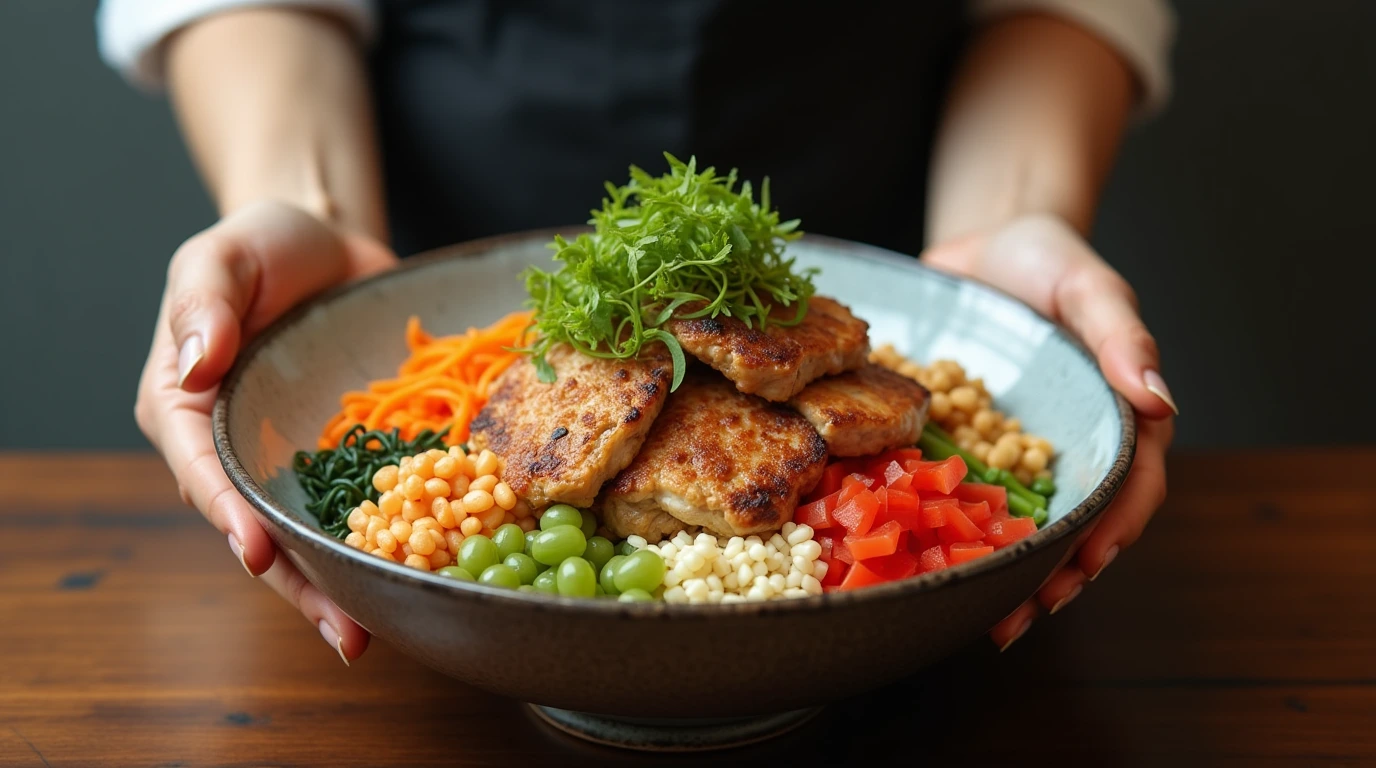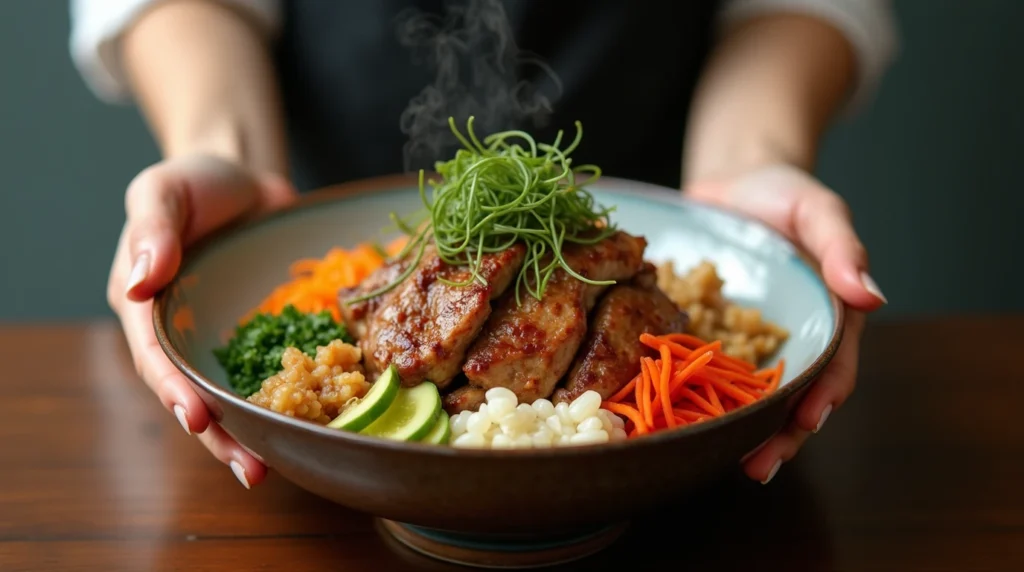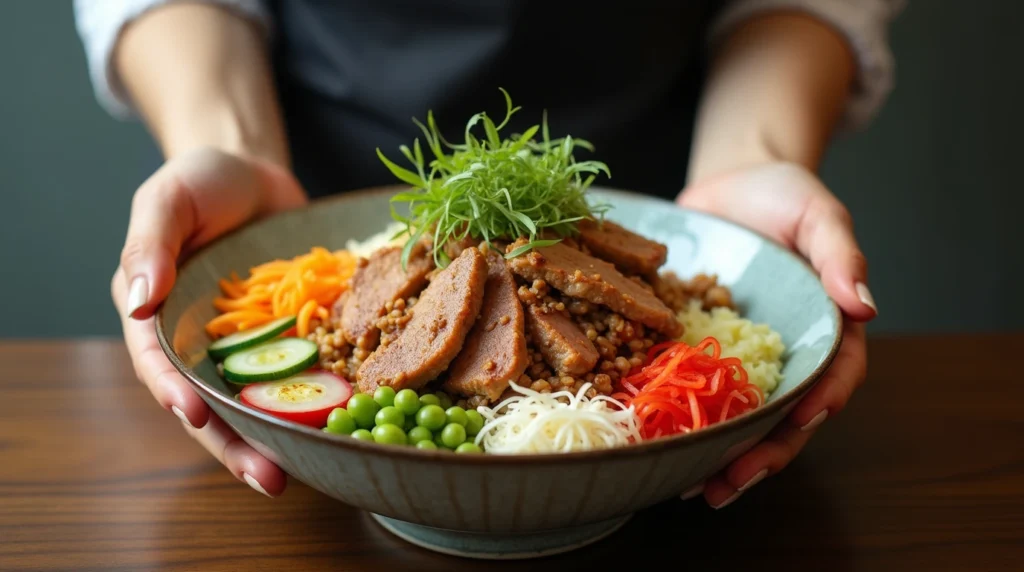How to Make Chicken Bibimbap

How to Make Chicken Bibimbap: A Step-by-Step Guide
Bibimbap, a traditional Korean dish known for its vibrant colors, variety of textures, and layers of flavor, is a meal that can be enjoyed any day of the week. While the classic bibimbap often uses beef or pork as the protein, today, you’ll learn how to make chicken bibimbap, a lighter, yet equally delicious alternative. In this comprehensive guide, you will discover how to prepare this dish from scratch, with easy-to-follow instructions, expert tips, and helpful advice for making your chicken bibimbap a perfect meal every time.
Table of Contents
What is Chicken Bibimbap? An Introduction to the Dish
Bibimbap literally translates to “mixed rice” in Korean, and it’s easy to see why. This dish is a harmonious combination of rice, sautéed vegetables, a protein (often beef, but chicken is a popular alternative), a fried egg, and the iconic gochujang (Korean chili paste). The key to a great bibimbap is balancing the various flavors—salty, spicy, and savory—while also making sure all the ingredients are cooked to perfection.
Chicken bibimbap is a variation that replaces the traditional beef with tender, marinated chicken. The chicken adds a lean, protein-packed element to the dish, while still allowing the bold flavors of the other components to shine. Whether you’re looking for a healthier twist or just a different take on the classic, chicken bibimbap is a satisfying and flavorful option.
Ingredients for Chicken Bibimbap: What You Need to Make This Dish
To make a delicious chicken bibimbap, gather the following ingredients. You’ll notice that it includes fresh vegetables, lean protein, and a few pantry staples. Here’s a quick breakdown:

| Ingredient | Amount | Notes |
|---|---|---|
| Boneless, skinless chicken breast | 2 breasts (sliced) | Thinly sliced for even cooking |
| Cooked rice | 2 cups | Short-grain rice preferred for its sticky texture |
| Carrots (julienned) | 1 large | For crunch and vibrant color |
| Spinach | 2 cups | Blanched and lightly seasoned |
| Zucchini (sliced) | 1 small | Lightly sautéed or grilled |
| Mushrooms | 1 cup | Sliced, stir-fried |
| Gochujang (Korean chili paste) | 2 tablespoons | Key for authentic flavor |
| Sesame oil | 1 tablespoon | For cooking and garnish |
| Egg | 1 (fried or poached) | For topping |
| Sesame seeds | 1 tablespoon | Garnish |
Preparing Chicken Bibimbap: A Step-by-Step Guide
Now, it’s time to dive into the step-by-step process of making your chicken bibimbap. The beauty of this dish lies in the layers of texture and flavor, and with a bit of preparation, you’ll have a well-rounded, delicious meal in no time.
Step 1: Marinate the Chicken
Start by marinating the chicken. This is a key step that ensures the chicken will be flavorful and tender. Combine soy sauce, minced garlic, sesame oil, and gochujang (or a mild chili paste if you prefer less heat). Let the chicken marinate for 15-30 minutes to allow the flavors to absorb.
While the chicken marinates, you can move on to preparing the other ingredients.
Step 2: Prepare the Vegetables
For this recipe, you’ll use a variety of vegetables to add color, crunch, and flavor. Here’s how to prepare each one:
- Carrots: Peel and julienne the carrots for easy, quick sautéing or raw use.
- Spinach: Blanch the spinach in boiling water for just a minute, then drain and season with a little sesame oil and salt.
- Zucchini: Slice the zucchini into thin half-moons, and sauté it lightly in a pan with sesame oil until just tender.
- Mushrooms: Slice and stir-fry the mushrooms with a little sesame oil until soft and golden brown.
Step 3: Cook the Rice
While the vegetables are cooking, prepare the rice. For bibimbap, short-grain rice is ideal because it’s sticky and will hold together when mixed with the other ingredients. Cook 2 cups of rice, and set it aside to cool slightly.
Step 4: Cook the Chicken
Now that the chicken has marinated, it’s time to cook it. Heat a pan over medium-high heat and add a bit of sesame oil. Pan-fry the chicken until golden brown on both sides and cooked through (about 4-5 minutes per side, depending on thickness).
Once the chicken is cooked, remove it from the pan and set it aside to rest for a couple of minutes before slicing it into thin strips.
Step 5: Fry the Egg
While the chicken is resting, crack an egg into a hot pan. Fry it sunny-side-up or cook it to your preferred doneness. The runny yolk will add richness to the bibimbap, so it’s best to keep the yolk intact.
Assembling the Chicken Bibimbap
Now that all the components are prepared, it’s time to assemble your chicken bibimbap.
- Start by placing a scoop of rice at the bottom of your bowl.
- Neatly arrange the sautéed vegetables (carrots, zucchini, mushrooms, and spinach) around the rice, making sure to leave space in the center for the chicken.
- Place the sliced chicken on top of the vegetables.
- Carefully place the fried egg in the center of the bowl, letting the yolk rest right on top of the chicken.
- Drizzle a little more sesame oil over the top for added flavor.
- Finish with a sprinkle of sesame seeds for texture and garnish.
You can either serve the gochujang on the side so people can add as much spice as they like, or mix it into the bowl for a richer, spicier flavor.
Variations and Customizations for Your Chicken Bibimbap
One of the best things about chicken bibimbap is how customizable it is. Whether you prefer more vegetables or a different protein, there are plenty of ways to make this dish your own. Here are a few variations:
- Vegetarian Option: Swap the chicken for tofu or even tempeh. Marinate the tofu in the same marinade as the chicken for added flavor.
- Spicy Level Adjustments: If you like more heat, add extra gochujang or even some chili flakes. You can also add kimchi for an extra kick.
- Different Vegetables: Experiment with other vegetables like bell peppers, sweet potato, or bean sprouts. You can roast or grill the vegetables for a different texture.
- More Protein Options: If you’re not a fan of chicken, you can also use beef, pork, or even shrimp for a unique take on bibimbap.

Tips for Making the Perfect Chicken Bibimbap Every Time
- Marinate the Chicken Well: The longer you marinate the chicken, the more flavorful it will be. However, even 15 minutes of marination will make a difference.
- Keep the Veggies Crisp: Don’t overcook the vegetables. You want them to maintain a little crunch to add texture to the dish.
- Fried Egg: If you prefer a crispy egg, cook it a little longer on low heat until the edges are golden and crisp.
- Serve Immediately: Bibimbap is best served fresh, but you can prep all the ingredients in advance for a quicker assembly during busy weeknights.
Health Benefits of Chicken Bibimbap
Not only is chicken bibimbap delicious, but it’s also a healthy meal. Here’s why:
- Lean Protein: Chicken breast is a great source of lean protein, which is important for muscle building and repair.
- Fiber-Rich Vegetables: The vegetables in bibimbap provide a wealth of vitamins and minerals. The spinach and carrots are especially high in antioxidants.
- Balanced Meal: This dish contains a balance of protein, healthy fats from sesame oil, and carbohydrates from rice, making it a well-rounded meal.
Serving Suggestions for Chicken Bibimbap
For a complete meal, serve your chicken bibimbap with a side of kimchi or pickled radishes for extra crunch and tang. You can also pair it with a light miso soup or a simple salad with a sesame dressing to round out the meal. For drinks, iced green tea or Korean barley tea would complement the flavors nicely.
Conclusion: Why Chicken Bibimbap Should Be Your Go-To Weeknight Dinner
Chicken bibimbap is a perfect option for a quick, healthy, and delicious weeknight meal. The beauty of this dish lies in its versatility, as you can mix and match vegetables, adjust the spice level, and use whatever protein you like. With the step-by-step instructions above, you can create a vibrant, flavorful meal that will satisfy your cravings and impress your family or guests.
Ready to give it a try? Gather your ingredients, follow the simple steps, and enjoy a bowl of homemade chicken bibimbap. Don’t forget to share your creations in the comments below and let us know how you customize your bibimbap!
Frequently Asked Questions (FAQs)
Q1: Can I use regular chicken breasts instead of sliced chicken?
Yes, you can. However, slicing the chicken thinly ensures it cooks quickly and evenly, which is important for a dish like bibimbap.
Q2: Can I make chicken bibimbap ahead of time?
While it’s best to cook the rice and chicken fresh, you can prepare the vegetables and even the chicken the night before. Just assemble everything when you’re ready to serve.
Q3: How can I make chicken bibimbap spicier?
If you like your bibimbap spicy, add more gochujang, or even use spicy chili flakes to kick up the heat.
Q4: Can I use brown rice instead of white rice?
Yes, brown rice is a healthier alternative, though it has a chewier texture and takes longer to cook.
